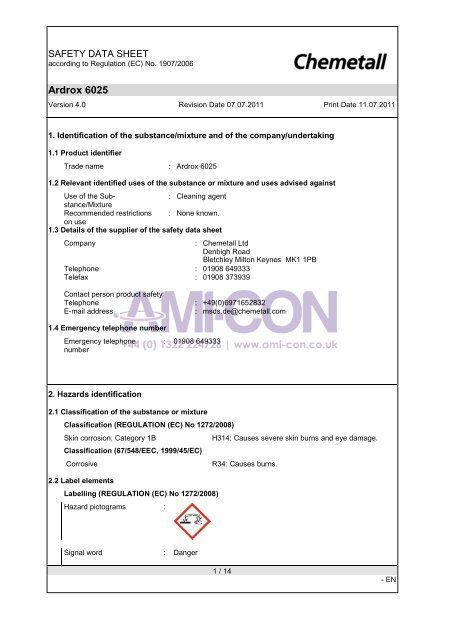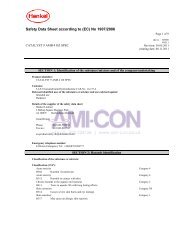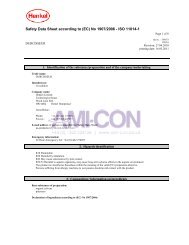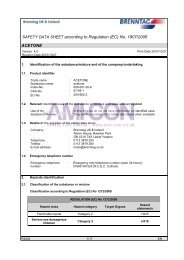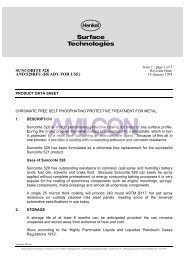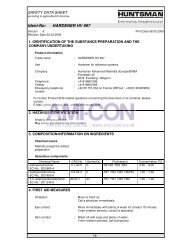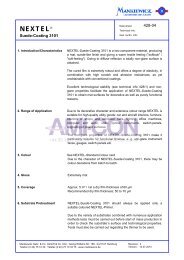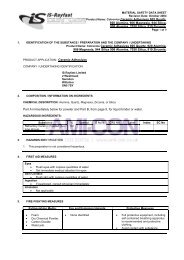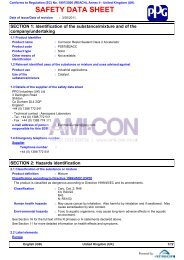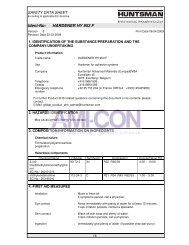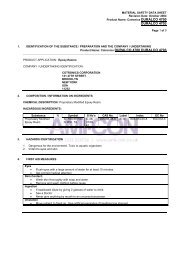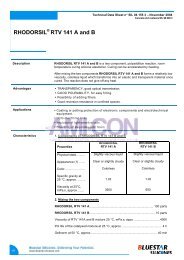Ardrox 6025 - AMI-CON
Ardrox 6025 - AMI-CON
Ardrox 6025 - AMI-CON
You also want an ePaper? Increase the reach of your titles
YUMPU automatically turns print PDFs into web optimized ePapers that Google loves.
SAFETY DATA SHEET<br />
according to Regulation (EC) No. 1907/2006<br />
<strong>Ardrox</strong> <strong>6025</strong><br />
Version 4.0 Revision Date 07.07.2011 Print Date 11.07.2011<br />
1. Identification of the substance/mixture and of the company/undertaking<br />
1.1 Product identifier<br />
Trade name : <strong>Ardrox</strong> <strong>6025</strong><br />
1.2 Relevant identified uses of the substance or mixture and uses advised against<br />
Use of the Substance/Mixture<br />
: Cleaning agent<br />
Recommended restrictions : None known.<br />
on use<br />
1.3 Details of the supplier of the safety data sheet<br />
Company<br />
: Chemetall Ltd<br />
Denbigh Road<br />
Bletchley Milton Keynes MK1 1PB<br />
Telephone : 01908 649333<br />
Telefax : 01908 373939<br />
Contact person product safety<br />
Telephone : +49(0)6971652832<br />
E-mail address<br />
: msds.de@chemetall.com<br />
1.4 Emergency telephone number<br />
Emergency telephone<br />
number<br />
: 01908 649333<br />
2. Hazards identification<br />
2.1 Classification of the substance or mixture<br />
Classification (REGULATION (EC) No 1272/2008)<br />
Skin corrosion, Category 1B<br />
H314: Causes severe skin burns and eye damage.<br />
Classification (67/548/EEC, 1999/45/EC)<br />
Corrosive<br />
R34: Causes burns.<br />
2.2 Label elements<br />
Labelling (REGULATION (EC) No 1272/2008)<br />
Hazard pictograms :<br />
Signal word : Danger<br />
1 / 14<br />
- EN
SAFETY DATA SHEET<br />
according to Regulation (EC) No. 1907/2006<br />
<strong>Ardrox</strong> <strong>6025</strong><br />
Version 4.0 Revision Date 07.07.2011 Print Date 11.07.2011<br />
Hazard statements : H314 Causes severe skin burns and eye damage.<br />
Precautionary statements : Prevention:<br />
P260<br />
Do not breathe dust/ fume/ gas/ mist/ vapours/<br />
spray.<br />
P262<br />
Do not get in eyes, on skin, or on clothing.<br />
P280<br />
Wear protective gloves/ protective clothing/<br />
eye protection/ face protection.<br />
Response:<br />
P301 + P330 + P331 IF SWALLOWED: rinse mouth. Do<br />
NOT induce vomiting.<br />
P303 + P361 + P353 IF ON SKIN (or hair): Remove/ Take<br />
off immediately all contaminated clothing.<br />
Rinse skin with water/ shower.<br />
P305 + P351 + P338 IF IN EYES: Rinse cautiously with water<br />
for several minutes. Remove contact<br />
lenses, if present and easy to do. Continue<br />
rinsing.<br />
P308<br />
IF exposed or concerned:<br />
P315<br />
Get immediate medical advice/ attention.<br />
Disposal:<br />
P501<br />
Dispose of contents/ container to an approved<br />
waste disposal plant.<br />
Hazardous components which must be listed on the label:<br />
1310-73-2 Sodium Hydroxide<br />
Additional Labelling:<br />
EUH208 Contains: Benzothiazole-2-thiolMay produce an allergic reaction.<br />
Labelling according to EC Directives (1999/45/EC)<br />
Hazard pictograms :<br />
Corrosive<br />
R-phrase(s) : R34 Causes burns.<br />
S-phrase(s) : S23 Do not breathe gas/fumes/vapour/spray.<br />
S24/25 Avoid contact with skin and eyes.<br />
S26<br />
In case of contact with eyes, rinse immediately<br />
with plenty of water and seek medical<br />
advice.<br />
S37/39 Wear suitable gloves and eye/face protection.<br />
S45<br />
In case of accident or if you feel unwell,<br />
2 / 14<br />
- EN
SAFETY DATA SHEET<br />
according to Regulation (EC) No. 1907/2006<br />
<strong>Ardrox</strong> <strong>6025</strong><br />
Version 4.0 Revision Date 07.07.2011 Print Date 11.07.2011<br />
S60<br />
seek medical advice immediately (show<br />
the label where possible).<br />
This material and its container must be<br />
disposed of as hazardous waste.<br />
Special labelling of certain<br />
mixtures<br />
: Safety data sheet available on request for professional users.<br />
: Ingredients according to Regulation (EC) No.648/2004 on<br />
detergents:<br />
Anionic surfactants, < 5 %<br />
Sensitising components<br />
: Benzothiazole-2-thiol<br />
May produce an allergic reaction.<br />
2.3 Other hazards<br />
The information required is contained in this Material Safety Data Sheet.<br />
3. Composition/information on ingredients<br />
3.1 Substances<br />
Identification: <strong>Ardrox</strong> <strong>6025</strong><br />
3.2 Mixtures<br />
Chemical nature<br />
Hazardous components<br />
: Aqueous solution of alkali salts and surfactants.<br />
Chemical Name<br />
Benzenesulfonic acid,<br />
Na-salt<br />
CAS-No.<br />
EC-No.<br />
Registration number<br />
Classification<br />
(67/548/EEC)<br />
Classification<br />
(REGULATION<br />
(EC) No<br />
1272/2008)<br />
127184-52-5 Xn; R22 Acute Tox. 4;<br />
H302<br />
Concentration<br />
[%]<br />
>= 2.5 - < 10<br />
2-Butoxyethanol 111-76-2<br />
203-905-0<br />
Xn; R20/21/22<br />
Xi; R36/38<br />
Acute Tox. 4;<br />
H332<br />
Acute Tox. 4;<br />
H312<br />
>= 1 - < 2.5<br />
Acute Tox. 4;<br />
H302<br />
3 / 14<br />
Eye Irrit. 2;<br />
H319<br />
- EN
SAFETY DATA SHEET<br />
according to Regulation (EC) No. 1907/2006<br />
<strong>Ardrox</strong> <strong>6025</strong><br />
Version 4.0 Revision Date 07.07.2011 Print Date 11.07.2011<br />
Skin Irrit. 2;<br />
H315<br />
Potassium silicate 1312-76-1<br />
215-199-1<br />
Xi; R36/38 Eye Irrit. 2;<br />
H319<br />
Skin Irrit. 2;<br />
H315<br />
>= 1 - < 2.5<br />
WEL substance :<br />
2-(3-<br />
Methoxypropoxy)propan-1-ol<br />
34590-94-8<br />
252-104-2<br />
Not a hazardous<br />
substance<br />
or mixture according<br />
to<br />
Regulation (EC)<br />
No. 1272/2008.<br />
>= 1 - < 2.5<br />
For the full text of the R-phrases mentioned in this Section, see Section 16.<br />
For the full text of the H-Statements mentioned in this Section, see Section 16.<br />
For the full text of the Notas mentioned in this Section, see Section 16.<br />
4. First aid measures<br />
4.1 Description of first aid measures<br />
General advice<br />
: First-aid crew: Ensure self-protection.<br />
Move out of dangerous area.<br />
Take off contaminated clothing and shoes immediately.<br />
If inhaled<br />
In case of skin contact<br />
In case of eye contact<br />
If swallowed<br />
: Move to fresh air.<br />
If symptoms persist, call a physician.<br />
: Wash off with soap and plenty of water.<br />
Call a physician immediately.<br />
: Rinse immediately with plenty of water, also under the eyelids.<br />
Call a physician immediately.<br />
: Clean mouth with water and drink afterwards plenty of water.<br />
Do NOT induce vomiting.<br />
Call a physician immediately.<br />
4.2 Most important symptoms and effects, both acute and delayed<br />
Symptoms<br />
: No information available.<br />
Risks<br />
: corrosive effects<br />
4 / 14<br />
- EN
SAFETY DATA SHEET<br />
according to Regulation (EC) No. 1907/2006<br />
<strong>Ardrox</strong> <strong>6025</strong><br />
Version 4.0 Revision Date 07.07.2011 Print Date 11.07.2011<br />
4.3 Indication of any immediate medical attention and special treatment needed<br />
Treatment<br />
: Treat symptomatically.<br />
For specialist advice physicians should contact the Poisons<br />
Information Service.<br />
5. Fire-fighting measures<br />
5.1 Extinguishing media<br />
Suitable extinguishing media<br />
: Carbon dioxide (CO2)<br />
Dry powder<br />
Alcohol-resistant foam<br />
Water spray<br />
Unsuitable extinguishing : High volume water jet<br />
media<br />
5.2 Special hazards arising from the substance or mixture<br />
Specific hazards during fire<br />
fighting<br />
: May form toxic gases on heating or in case of fire.<br />
Carbon monoxide<br />
Carbon dioxide (CO2)<br />
Sulphur oxides<br />
5.3 Advice for firefighters<br />
Special protective equipment<br />
for fire-fighters<br />
Further information<br />
: In the event of fire, wear self-contained breathing apparatus.<br />
: Use water spray to cool unopened containers.<br />
6. Accidental release measures<br />
6.1 Personal precautions, protective equipment and emergency procedures<br />
Personal precautions<br />
: Ensure adequate ventilation.<br />
Wear personal protective equipment.<br />
6.2 Environmental precautions<br />
Environmental precautions<br />
: Do not flush into surface water or sanitary sewer system.<br />
Avoid subsoil penetration.<br />
Inform the relevant authorities if it enters sewers, aquatic environment<br />
or soil.<br />
6.3 Methods and materials for containment and cleaning up<br />
Methods for cleaning up<br />
: Ensure adequate ventilation.<br />
Contain spillage, soak up with non-combustible absorbent<br />
material, (e.g. sand, earth, diatomaceous earth, vermiculite)<br />
and transfer to a container for disposal according to local /<br />
national regulations (see section 13).<br />
5 / 14<br />
- EN
SAFETY DATA SHEET<br />
according to Regulation (EC) No. 1907/2006<br />
<strong>Ardrox</strong> <strong>6025</strong><br />
Version 4.0 Revision Date 07.07.2011 Print Date 11.07.2011<br />
6.4 Reference to other sections<br />
See chapter 8 and 13<br />
7. Handling and storage<br />
7.1 Precautions for safe handling<br />
Advice on safe handling<br />
: Provide sufficient air exchange and/or exhaust in work rooms.<br />
Have eye wash bottle or eye rinse ready at the work place.<br />
Advice on protection against<br />
fire and explosion<br />
: Normal measures for preventive fire protection.<br />
7.2 Conditions for safe storage, including any incompatibilities<br />
Requirements for storage<br />
areas and containers<br />
Further information on storage<br />
conditions<br />
: Protect from frost.<br />
Storage temperature : > 0 °C<br />
: Keep containers tightly closed in a cool, well-ventilated place.<br />
Keep away from heat.<br />
7.3 Specific end uses<br />
Specific use(s)<br />
: Cleaning agent<br />
8. Exposure controls/personal protection<br />
8.1 Control parameters<br />
Components CAS-No. Value<br />
Control parameters<br />
2-<br />
111-76-2 TWA 20 ppm<br />
Butoxyethanol<br />
98 mg/m3<br />
Update<br />
Basis<br />
2000-06-16 2000/39/EC<br />
Further information<br />
: skin: Identifies the possibility of significant uptake through the skin<br />
Indicative<br />
STEL<br />
50 ppm<br />
246 mg/m3<br />
2000-06-16 2000/39/EC<br />
Further information<br />
: skin: Identifies the possibility of significant uptake through the skin<br />
Indicative<br />
TWA 25 ppm 2005-04-06 GB EH40<br />
6 / 14<br />
- EN
SAFETY DATA SHEET<br />
according to Regulation (EC) No. 1907/2006<br />
<strong>Ardrox</strong> <strong>6025</strong><br />
Version 4.0 Revision Date 07.07.2011 Print Date 11.07.2011<br />
Further information<br />
: Sk: Can be absorbed through skin. The assigned substances are those for which there are<br />
concerns that dermal absorption will lead to systemic toxicity.<br />
STEL 50 ppm 2005-04-06 GB EH40<br />
: Sk: Can be absorbed through skin. The assigned substances are those for which there are<br />
concerns that dermal absorption will lead to systemic toxicity.<br />
Further information<br />
2-(3-<br />
Methoxypro-<br />
poxy)propan-<br />
1-ol<br />
Further information<br />
34590-94-<br />
8<br />
TWA<br />
50 ppm<br />
308 mg/m3<br />
: skin: Identifies the possibility of significant uptake through the skin<br />
Indicative<br />
2000-06-16 2000/39/EC<br />
TWA<br />
50 ppm<br />
308 mg/m3<br />
2005-04-06 GB EH40<br />
Further information<br />
: Sk: Can be absorbed through skin. The assigned substances are those for which there are<br />
concerns that dermal absorption will lead to systemic toxicity.<br />
Where no specific short-term exposure limit is listed, a figure three times the long-term exposure<br />
should be used<br />
8.2 Exposure controls<br />
Engineering measures<br />
Ensure adequate ventilation, especially in confined areas.<br />
Personal protective equipment<br />
Respiratory protection<br />
: In case of insufficient ventilation wear suitable respiratory<br />
equipment.<br />
Recommended Filter type:<br />
A-P2<br />
Hand protection<br />
: Neoprene gloves<br />
Protective gloves complying with EN 374.<br />
Please observe the instructions regarding permeability and<br />
breakthrough time which are provided by the supplier of the<br />
gloves. Also take into consideration the specific local conditions<br />
under which the product is used, such as the danger of<br />
cuts, abrasion, and the contact time.<br />
Eye protection : Eye protection (EN 166)<br />
Tightly fitting safety goggles<br />
Have eye wash bottle or eye rinse ready at the work place.<br />
7 / 14<br />
- EN
SAFETY DATA SHEET<br />
according to Regulation (EC) No. 1907/2006<br />
<strong>Ardrox</strong> <strong>6025</strong><br />
Version 4.0 Revision Date 07.07.2011 Print Date 11.07.2011<br />
Skin and body protection<br />
Hygiene measures<br />
: Chemical resistant protective clothing according to DIN EN<br />
13034 (Type 6)<br />
: Take off contaminated clothing and shoes immediately.<br />
Keep away from food, drink and animal feedingstuffs.<br />
Wash hands before breaks and immediately after handling the<br />
product.<br />
Avoid contact with skin and eyes.<br />
Do not breathe vapour.<br />
Do not breathe spray.<br />
Environmental exposure controls<br />
General advice<br />
: Do not flush into surface water or sanitary sewer system.<br />
Avoid subsoil penetration.<br />
Inform the relevant authorities if it enters sewers, aquatic environment<br />
or soil.<br />
9. Physical and chemical properties<br />
9.1 Information on basic physical and chemical properties<br />
Appearance<br />
: liquid<br />
Colour<br />
: green<br />
Odour<br />
Flash point<br />
Ignition temperature<br />
: characteristic<br />
: not applicable<br />
: not applicable<br />
pH : 12.3<br />
at<br />
20 °C<br />
(undiluted)<br />
Melting point/range : ca. -2 °C<br />
Boiling point/boiling range : ca. 100 °C<br />
Density<br />
: 1.055 g/cm3<br />
at 20 °C<br />
Water solubility<br />
: soluble<br />
8 / 14<br />
- EN
SAFETY DATA SHEET<br />
according to Regulation (EC) No. 1907/2006<br />
<strong>Ardrox</strong> <strong>6025</strong><br />
Version 4.0 Revision Date 07.07.2011 Print Date 11.07.2011<br />
Viscosity, dynamic<br />
: 5 mPa*s<br />
at 20 °C<br />
9.2 Other information<br />
Explosivity<br />
: no explosion risk<br />
10. Stability and reactivity<br />
10.1 Reactivity<br />
No dangerous reaction known under conditions of normal use.<br />
10.2 Chemical stability<br />
Stable under normal conditions.<br />
10.3 Possibility of hazardous reactions<br />
Hazardous reactions<br />
: None known.<br />
10.4 Conditions to avoid<br />
Conditions to avoid<br />
10.5 Incompatible materials<br />
Materials to avoid<br />
: Protect from frost.<br />
: Strong acids<br />
10.6 Hazardous decomposition products<br />
Risk of decomposition.<br />
: No decomposition if stored and applied as directed.<br />
11. Toxicological information<br />
11.1 Information on toxicological effects<br />
Acute toxicity<br />
Acute oral toxicity<br />
: Acute toxicity estimate: 8,156.61 mg/kg<br />
Method: Calculation method<br />
Acute oral toxicity<br />
2-Butoxyethanol<br />
2-(3-<br />
Methoxypropoxy)propan-1-ol<br />
: Acute toxicity estimate: 500 mg/kg<br />
Method: Converted acute toxicity point estimate<br />
: LD50: 5,135.0 mg/kg<br />
Species: rat<br />
9 / 14<br />
- EN
SAFETY DATA SHEET<br />
according to Regulation (EC) No. 1907/2006<br />
<strong>Ardrox</strong> <strong>6025</strong><br />
Version 4.0 Revision Date 07.07.2011 Print Date 11.07.2011<br />
Acute inhalation toxicity<br />
: Acute toxicity estimate: 470.09 mg/l<br />
Method: Calculation method<br />
Acute dermal toxicity<br />
: Acute toxicity estimate: 47,008.55 mg/kg<br />
Method: Calculation method<br />
Acute dermal toxicity<br />
2-Butoxyethanol<br />
2-(3-<br />
Methoxypropoxy)propan-1-ol<br />
Skin corrosion/irritation<br />
Skin irritation<br />
: Acute toxicity estimate: 1,100 mg/kg<br />
Method: Converted acute toxicity point estimate<br />
: LD50: > 19,000.0 mg/kg<br />
Species: rat<br />
: Causes severe burns.<br />
Serious eye damage/eye irritation<br />
Eye irritation<br />
: Causes serious eye damage.<br />
Respiratory or skin sensitization<br />
Sensitisation<br />
: no data available<br />
Further information<br />
: If swallowed, severe burns in the oral cavity and throat as well<br />
as danger of perforation of the digestive tract and stomach.<br />
12. Ecological information<br />
12.1 Toxicity<br />
Toxicity to fish<br />
2-Butoxyethanol<br />
2-(3-<br />
Methoxypropoxy)propan-1-ol<br />
: LC50: 1,490 mg/l<br />
Exposure time: 96 h<br />
Species: Lepomis macrochirus (Bluegill sunfish)<br />
: LC50: > 10,000 mg/l<br />
Exposure time: 96 h<br />
Species: Pimephales promelas (fathead minnow)<br />
Toxicity to daphnia and other aquatic invertebrates.<br />
10 / 14<br />
- EN
SAFETY DATA SHEET<br />
according to Regulation (EC) No. 1907/2006<br />
<strong>Ardrox</strong> <strong>6025</strong><br />
Version 4.0 Revision Date 07.07.2011 Print Date 11.07.2011<br />
2-Butoxyethanol<br />
2-(3-<br />
Methoxypropoxy)propan-1-ol<br />
: EC50: 1,720 mg/l<br />
Exposure time: 24 h<br />
Species: Daphnia<br />
: LC50: 1,919 mg/l<br />
Exposure time: 48 h<br />
Species: Daphnia<br />
Toxicity to algae<br />
2-Butoxyethanol<br />
2-(3-<br />
Methoxypropoxy)propan-1-ol<br />
: Cell multiplication inhibition test EC0: 900 mg/l<br />
Exposure time: 168 h<br />
Species: Scenedesmus quadricauda (Green algae)<br />
: EC50: > 969 mg/l<br />
Exposure time: 96 h<br />
Species: Pseudokirchneriella subcapitata<br />
Toxicity to bacteria<br />
2-Butoxyethanol<br />
: EC0: 700 mg/l<br />
Exposure time: 16 h<br />
Species: Pseudomonas putida<br />
12.2 Persistence and degradability<br />
Biodegradability<br />
: The surfactants contained in this preparation comply with the<br />
biodegradability criteria as laid down in Regulation (EC)<br />
No.648/2004 on detergents<br />
Biodegradability<br />
2-Butoxyethanol : 100 %<br />
Testing period: 28 d<br />
Readily biodegradable<br />
12.3 Bioaccumulative potential<br />
Bioaccumulation<br />
: no data available<br />
12.4 Mobility in soil<br />
Distribution among environmental<br />
compartments<br />
: no data available<br />
12.5 Results of PBT and vPvB assessment<br />
no data available<br />
2-Butoxyethanol<br />
: This substance is not considered to be persistent, bioaccumulating<br />
nor toxic (PBT).<br />
11 / 14<br />
- EN
SAFETY DATA SHEET<br />
according to Regulation (EC) No. 1907/2006<br />
<strong>Ardrox</strong> <strong>6025</strong><br />
Version 4.0 Revision Date 07.07.2011 Print Date 11.07.2011<br />
12.6 Other adverse effects<br />
Chemical Oxygen Demand<br />
(COD)<br />
Additional ecological information<br />
: 270 mg/g<br />
: water endangering<br />
Do not flush into surface water or sanitary sewer system.<br />
Avoid subsoil penetration.<br />
Even leakage of small amounts in the subsoil can contaminate<br />
drinking water.<br />
13. Disposal considerations<br />
13.1 Waste treatment methods<br />
Product<br />
Contaminated packaging<br />
: Dispose of in accordance with local regulations.<br />
: Dispose of as unused product.<br />
Waste Code : Waste codes should be assigned by the user, preferably in<br />
discussion with the waste disposal authorities.<br />
14. Transport information<br />
ADR<br />
UN number : 1719<br />
UN proper shipping name : CAUSTIC ALKALI LIQUID,N.O.S. Potassium silicate<br />
Transport hazard class(es) : 8<br />
Packing group<br />
: III<br />
Classification Code<br />
: C5<br />
Hazard identification No : 80<br />
Packing instruction (LQ) : LQ19<br />
Labels : 8<br />
Tunnel restriction code : (E),<br />
Environmentally hazardous : no<br />
IATA<br />
UN number : 1719<br />
Description of the goods : CAUSTIC ALKALI LIQUID,N.O.S. Potassium silicate<br />
Class : 8<br />
Packing group<br />
: III<br />
Labels : 8<br />
Packing instruction (cargo<br />
aircraft)<br />
IATA_C<br />
Environmentally hazardous<br />
: 856<br />
: no<br />
12 / 14<br />
- EN
SAFETY DATA SHEET<br />
according to Regulation (EC) No. 1907/2006<br />
<strong>Ardrox</strong> <strong>6025</strong><br />
Version 4.0 Revision Date 07.07.2011 Print Date 11.07.2011<br />
Packing instruction (passenger<br />
aircraft)<br />
IATA_P<br />
Environmentally hazardous<br />
: 852<br />
: no<br />
IMDG<br />
UN number : 1719<br />
Description of the goods : CAUSTIC ALKALI LIQUID,N.O.S. Potassium silicate<br />
Class : 8<br />
Packing group<br />
: III<br />
Labels : 8<br />
EmS Number 1<br />
: F-A<br />
EmS Number 2<br />
: S-B<br />
Marine pollutant<br />
: no<br />
RID<br />
UN number : 1719<br />
Description of the goods : CAUSTIC ALKALI LIQUID,N.O.S. Potassium silicate<br />
Transport hazard class(es) : 8<br />
Packing group<br />
: III<br />
Classification Code<br />
: C5<br />
Hazard identification No : 80<br />
Labels : 8<br />
Packing instruction (LQ) : LQ19<br />
Environmentally hazardous : no<br />
15. Regulatory information<br />
15.1 Safety, health and environmental regulations/legislation specific for the substance or mixture<br />
Water contaminating class<br />
(Germany)<br />
: WGK 2 water endangering<br />
VWVWS A4<br />
Other regulations<br />
: The product is classified and labelled in accordance with EC<br />
directives or respective national laws.<br />
Regional or national implementations of GHS may not implement<br />
all hazard classes and categories.<br />
15.2 Chemical Safety Assessment<br />
A Chemical Safety Assessment is not required for this substance.<br />
16. Other information<br />
Full text of R-phrases referred to under sections 2 and 3<br />
13 / 14<br />
- EN
SAFETY DATA SHEET<br />
according to Regulation (EC) No. 1907/2006<br />
<strong>Ardrox</strong> <strong>6025</strong><br />
Version 4.0 Revision Date 07.07.2011 Print Date 11.07.2011<br />
R20/21/22<br />
Harmful by inhalation, in contact with skin and if swallowed.<br />
R22<br />
Harmful if swallowed.<br />
R34<br />
Causes burns.<br />
R36/38 Irritating to eyes and skin.<br />
Full text of H-Statements referred to under sections 2 and 3.<br />
H302<br />
Harmful if swallowed.<br />
H312<br />
Harmful in contact with skin.<br />
H314<br />
Causes severe skin burns and eye damage.<br />
H315<br />
Causes skin irritation.<br />
H319<br />
Causes serious eye irritation.<br />
H332<br />
Harmful if inhaled.<br />
Further information<br />
The information provided is based on our current knowledge and experience and apply to the product<br />
as delivered. Regarding the product properties, these are not guaranteed. The delivery of this safety<br />
datasheet does not free the recipient of the product from his own responsibility to follow the relevant<br />
rules and regulations concerning this product.<br />
14 / 14<br />
- EN


